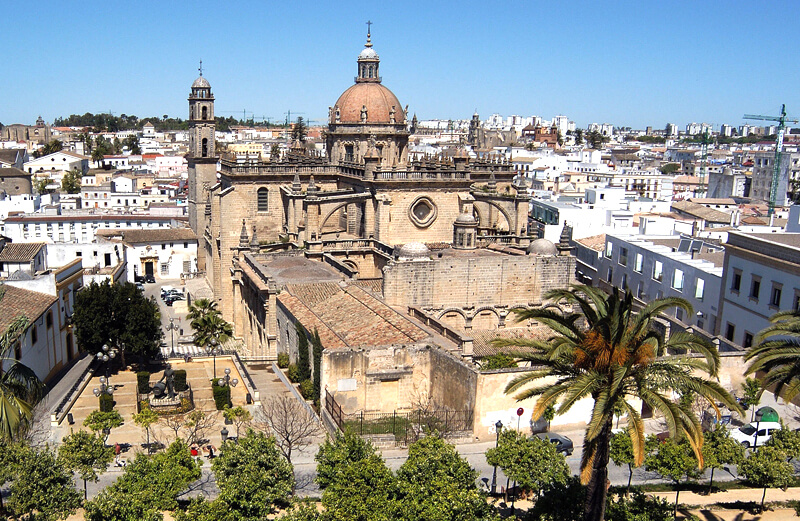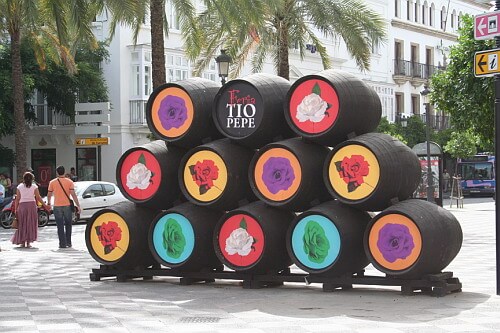Sherry – The Pride of Jerez de la Frontera
Now that you have tasted some of the tapas in Madrid it is time to travel down south to the beautiful town of Jerez. The first association when you mention the name of Jerez, or its full name Jerez de Ia Frontera, should be sherry. True, Jerez is known as the cradle of flamenco, and flamenco festival that is held every year is still one of the most important in the world.
About the Royal Riding School with thoroughbred horses, Gene Hackman and Denzel Washington discussed in the movie “Crimson Tide”.
Jerez is proud of corridas and breeding thoroughbred bulls, but when leaving the plane at the airport it is clear what are local people most proud of and what is more important than bulls and horses. In fact, along airport runway you can see barrels from the basement of leading sherry supplier in Jerez. Sherry and Jerez are one, from the earliest history until today.
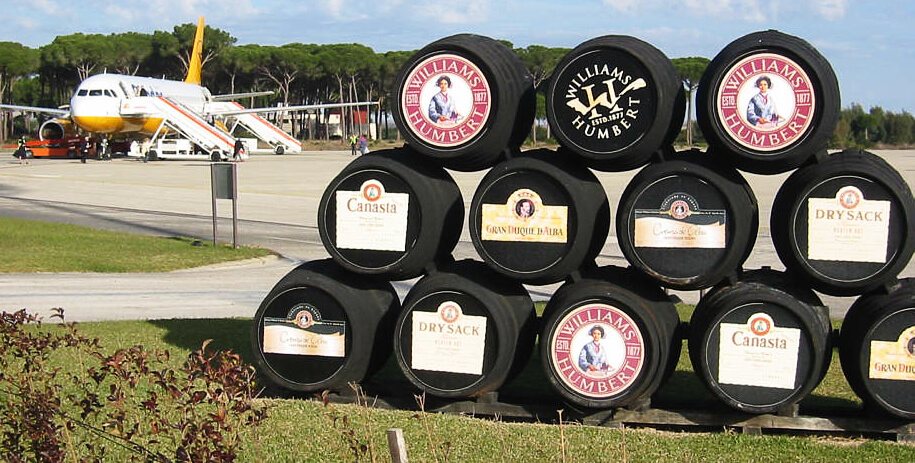
As soon as you land on Jerez de la Frontera airport, you understand how important sherry is to this region.
Three millenniums of sherry making
First vineyards in the Jerez countryside brought Phoenicians around 1100 BC, and during the reign of the Greeks and the Romans wine making was improved, as shown by many archaeological finds. Even the Māori who occupied Andalusia, did not interrupt production of wine in the south of Spain.
Although the Koran does not approve of alcohol, the invaders had an understanding of the region that lives and dies with the wines. Moreover, Māori are responsible for the name of the town and drink. The maps for the first time mentioned the word serisime from which arise expressions xerez and sherry.
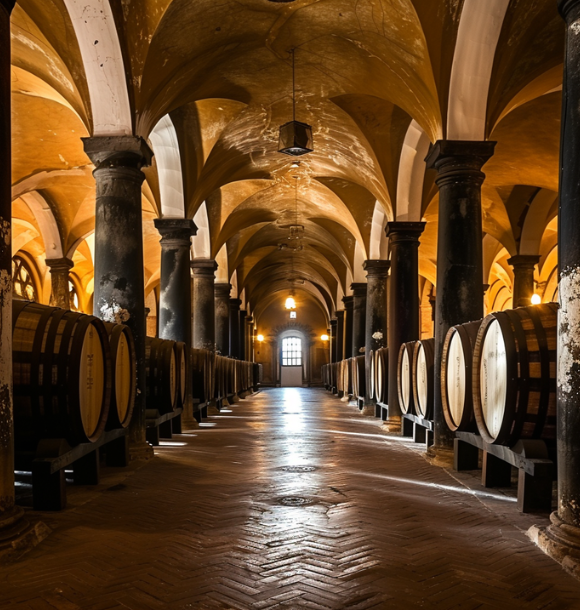
During the 12th century, while the Māori were present in Andalusia, sherry was already exported, mainly to England, under the name seris. From then until the present day England is a major market for sherry. After all, a treasure in a barrel was one of the main motives to Sir Francis Drake to rob Cadiz in 1587.
Even Magellan on his historic voyage from the Sanlucar de Barrameda, one of the two key ports for sherry export, loaded large quantities of sherry to his ships. He spent more money on sherry than on weapons. The great bard William Shakespeare in his favorite tavern Boar’s Head almost daily drank large quantities of sherry, and often it is mentioned in his works.
Thanks to the sherry, in the 17th and 18th century to Jerez came many British merchants who run their own businesses there. Finally, a real boom in the production of sherry began in the 19th century when the sherry and Jerez are recorded on the global wine maps.
Jerez today, a city with about 200,000 inhabitants, at first glance seems a little sleepy, but exudes an irresistible glory of past times, and at every step there is a set of decorative barrels and hardly anywhere in the world there is such a huge city that is inextricably linked to the wine industry.
Magical triangle
Since Jerez is located in southern Spain, in Andalusia, he has more than 300 sunny days, but like Bordeaux, it is influenced by the Atlantic Ocean, whose winds constantly bring moist sea air, extremely important in the ripening of grapes.
This is particularly felt in the famous sherry triangle comprising of Jerez de Ia Frontera, El Puerto de Santa Maria and Sanlucar de Barrameda where dominates albariza, calcareous white soil.
Because it is rich in limestone and silica, albariza retains moisture very well, which is crucial to the vine survival in such a hot and dry summer climate where there’s almost no rain falls.
At the mention of sherry people usually think of the sweet wine, which is not true. Sherry is a wine strengthened with alcohol. By nature it is dry, but by the method of production and maturation, there are various types of sherry, from very dry to very sweet.
A method of strengthening wine with alcohol was developed almost by accident, as a precaution during transport. Sherry from Jerez is made of only three sorts of grapes. The dominant sort is Palomino (about 90%), while the rest consists of Pedro Ximenez and Moscatel.
The biggest difference in the production of sherry in relation to the production of wine is the addition of alcohol after fermentation. Specifically, after the wine ferments in tanks (around December it is about 11% alcohol), a layer of yeast called flor is added and it is also the moment when the fate of the sherry is sealed.
All the colors of sherry
In principle sherry fermentation can occur under a layer of flora or by oxidation without affecting flora. Pale, petty wine pure on the nose, is separated to ripen under the flora and then you get “fine sherry” (or manzanilla, how these sorts are called in Cadiz).
This wine than intensifies to more than 15% of alcohol. On the other hand, there is an oloroso wine with more body that increases above 17% of alcohol. Even a layman can immediately distinguish pale fino from dark brown olorosa.
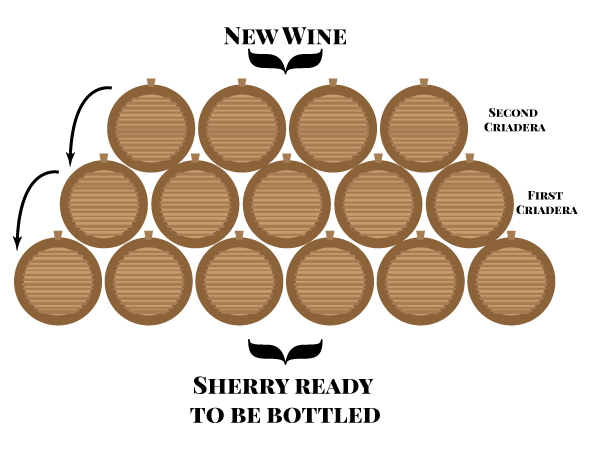
Solera process is pouring wine from barrel to barrel during at least three years which allows small variations in the quality of the sherry, which is bottled only from the last row of barrels.
The difference is, in addition, in the fact that in the case of wine aging, flor remains permanently on the surface and prevents contact with air. Flora is unique to this area, consisting of a layer of yeast from saccharomyces family.
They feed on alcohol and sugar in the wine, making them dry and in this process wine gets its characteristic flavor and tones. This process is called biological maturation, crianza biological. Unlike wine, which rips olorosa, because of more alcohol no subsequent flora is created (as flor dies when the alcohol concentration is greater than 15%).
Oloroso matures with constant interaction with oxygen, a process called oxidative maturation or crianza oxidative.
Certainly, there are many variations of the processes that give different types of sherry. So, when the fino at one point stops ripening under flora (when the flora dies or when you add more alcohol) it continues to ripen as oxidative oloroso which produces popular amontillado sherry. Blending dry wines with sweet ones, to get a sweeter taste, results in medium and cream sherry.
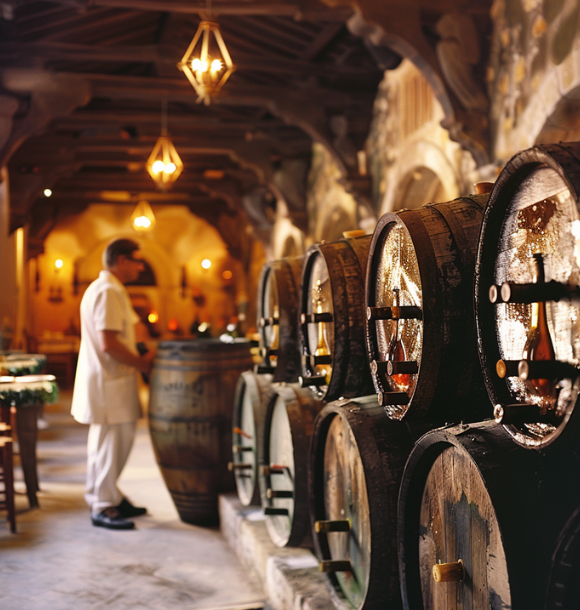
Bodega
The whole culture of sherry in Jerez revolves around the bodega. Cellar intended for the production of sherry. Arriving in any of them, it is immediately noticeable special way the barrels are stacked, usually in three or four rows.
It is a process of maturation in which only in the top row cask (Criadero) young wine is poured that begins its gradual path to the bottom row (Solera) from which it is poured. Path of 3 to 9 casks is often called the solera process, and the effects are interesting.
A small part of sherry is poured, never more than a third, and there is always a small chance that in any part of the sherry there is a sherry old at least as the barrels. That’s why the year of sherry production is practically impossible to decide, which is not really necessary, because thanks to solera, sherry from certain bodega is almost always of equal quality. In addition, the solera guarantees that every sherry in the barrel is at least three years old.
Still, even if you do not care about age, if you do find a bottle with the label VOS (Vinum Optimum Signatum) you will know that the wine was aged for 20 years, while confirmation Vorsah (Vinurn Optimum Rare Signatum) means the wines are older than 30 years.
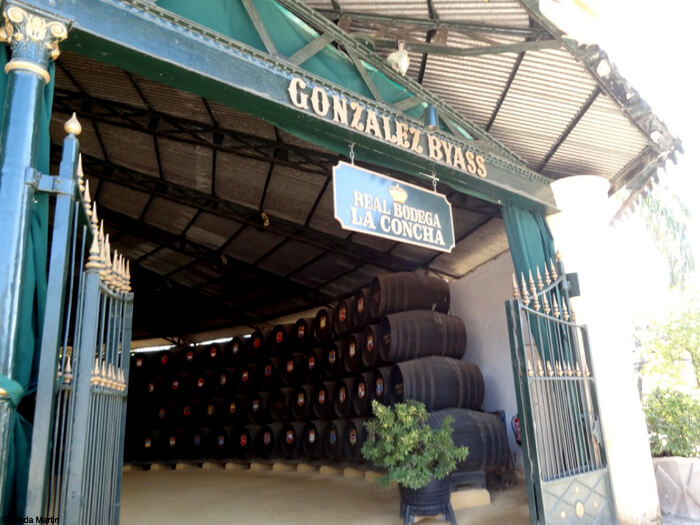
La Concha, one of the most famous Gonzlez Byass bodegas. Famous by No Pepe sherry and the dome made by Gustav Eiffel.
Sherry today
Although sherry triangle still has barely 10 thousand hectares of vineyards in the region, it annually produces more than 50 million liters of wine. One-third finish in the UK, while the Spaniards and the Dutch drink one quarter. Interestingly, although most produced is fino and manzanilla, English drink cream and pale cream. The rarest and most prized sherry is Cortado which account for less than 1% of production.
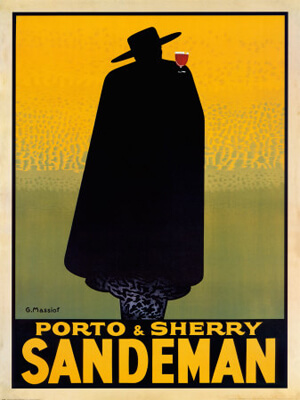
One of the most easily recognizable trademarks is famous Sandeman’s Don, the mysterious caballero. The character originated in 1928, invented by Massiot George Scott Brown.
Anyway, in the triangle there are 64 registered sherry bodega, which has long become tourist attractions. After all, you’ve surely heard of bodega Gonzales Byass, Williams & Humbert, Sandeman, Pedro Domecq, Osborne, Emilio Lustau?
The most famous (although with 1350 hectares of vineyards is the largest), and probably the most popular bodega is Gonzales & Byass which produce famous fino Tio Pepe, a trademark of the company which is completely dry sherry.
This beautiful complex of bodegas is located next to the fortress and cathedral, and particularly interesting is bodega La Concha built in 1862 on the occasion of visit of Spanish Queen Izabela II. Metal dome of the bodega is designed by the famous Gustave Eiffel.
Similar reputation enjoys bodega Williams & Humbert, located at the entrance to the city. With 180,000 m2 and a whopping 60,000 barrels it is the largest wine cellar in Europe. The winery organizes few times a week equestrian performance.
Their brand Dry Sack for more than a century is synonymous with superb sherry, and have a vintage room with a collection of old sherry barrels for each year from the 1920’s until today.
The largest winery in Jerez, with 1,500 hectares of vineyards, is Pedro Domecq. Their bodega La Mezquita (the mosque) with white walls and arches is one of the most beautiful wine cellars in the world. Certainly, there is also a recognizable Sandeman, the famous port and sherry producer. Sandeman’s bodega is even a museum. Anyway, take the copita, a sherry glass, and discover your favorite sort.
Sherry categories
There are two main categories: fino and oloroso, and the rest are subdivisions and combinations
- Fino teme una – is class of lightweight sherry, which always ripens under flora and can be drunk un-amplified with alcohol.
- Manzanilla – same as fino just as this one comes from Sanlucara de Barramede.
- Amontillado – a similar mode of production as a fino, but ripens oxidative.
- Darker Oloroso – It is also emphasized dark and rich sherry who always ripens oxidative.
- Palo Cortado – Sherry that began as a fino, was amontillado and ends as oloroso, rarest and most priced Sherry.
- Pale Cream, Medium Cream – Cream is dark, sweetened oloroso with intense flavor, full body and aroma. Pale Cream is produced by sweetening fino and Medium Cream by sweetening amontillado.
- Pedro Ximenez – sweet, thick and dark, with the taste of raisins drying in the sun. Serves as sweetener to other types of sherry.
- Moscatel – Sherry made of the grapes of the same name

